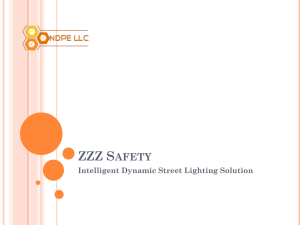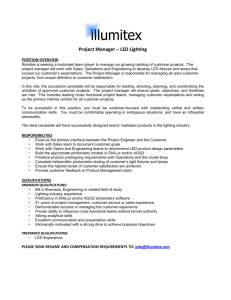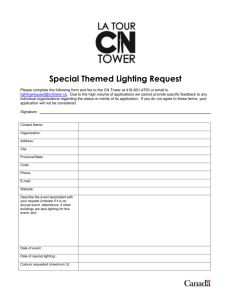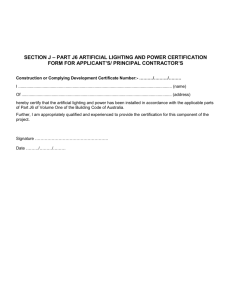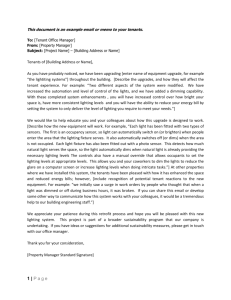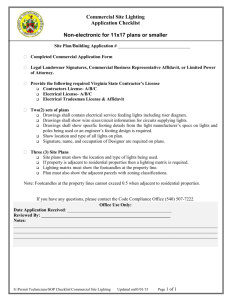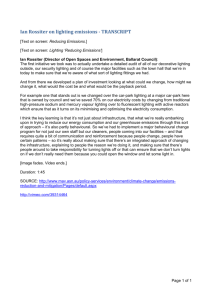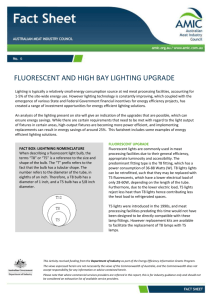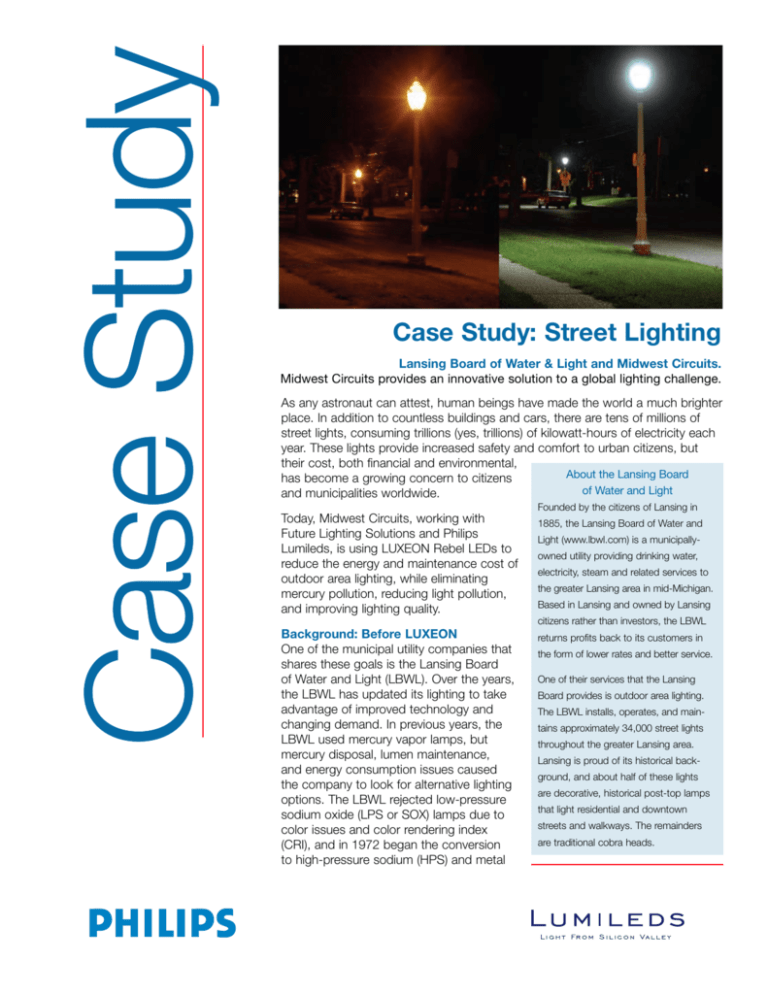
Case Study
Case Study: Street Lighting
Lansing Board of Water & Light and Midwest Circuits.
Midwest Circuits provides an innovative solution to a global lighting challenge.
As any astronaut can attest, human beings have made the world a much brighter
place. In addition to countless buildings and cars, there are tens of millions of
street lights, consuming trillions (yes, trillions) of kilowatthours of electricity each
year. These lights provide increased safety and comfort to urban citizens, but
their cost, both financial and environmental,
About the Lansing Board
has become a growing concern to citizens
of Water and Light
and municipalities worldwide.
Founded by the citizens of Lansing in
Today, Midwest Circuits, working with
Future Lighting Solutions and Philips
Lumileds, is using LUXEON Rebel LEDs to
reduce the energy and maintenance cost of
outdoor area lighting, while eliminating
mercury pollution, reducing light pollution,
and improving lighting quality.
1885, the Lansing Board of Water and
Light (www.lbwl.com) is a municipally
owned utility providing drinking water,
electricity, steam and related services to
the greater Lansing area in midMichigan.
Based in Lansing and owned by Lansing
citizens rather than investors, the LBWL
Background: Before LUXEON
One of the municipal utility companies that
shares these goals is the Lansing Board
of Water and Light (LBWL). Over the years,
the LBWL has updated its lighting to take
advantage of improved technology and
changing demand. In previous years, the
LBWL used mercury vapor lamps, but
mercury disposal, lumen maintenance,
and energy consumption issues caused
the company to look for alternative lighting
options. The LBWL rejected lowpressure
sodium oxide (LPS or SOX) lamps due to
color issues and color rendering index
(CRI), and in 1972 began the conversion
to highpressure sodium (HPS) and metal
returns profits back to its customers in
the form of lower rates and better service.
One of their services that the Lansing
Board provides is outdoor area lighting.
The LBWL installs, operates, and main
tains approximately 34,000 street lights
throughout the greater Lansing area.
Lansing is proud of its historical back
ground, and about half of these lights
are decorative, historical posttop lamps
that light residential and downtown
streets and walkways. The remainders
are traditional cobra heads.
halide (MH). Today, the vast majority of Lansing street lights are high pressure sodium, which has provided the best
balance of cost, efficiency, and CRI for general use. Metal halides have been used sparingly in applications where CRI is
critical, such as car dealer lots, but their relatively short life (about 2 years) and higher initial cost make them about three
times as expensive as HPS. In fact, both HPS and MH technologies have significant drawbacks.
Mercury and Halogens
Like nearly all high intensity discharge (HID) lighting, highpressure sodium and metal halide lamps contain mercury and
halogen gas, which are toxic substances that require special disposal as hazardous waste. This increases disposal cost
and has detrimental environment impacts.
Lifetime
HPS and MH lamps have effective lifetimes on the order of 8,00016,000 hours—only 24 years of use in street lighting
applications. LBWL has several relamping crews, who routinely replace approximately 25% of the LBWL's lights each
year on a regular maintenance schedule, but even so, they have additional outages that require "spot relamping."
Color Rendering
High pressure sodium lamps produce a color of light that is considered less pleasing than whiter lights. The CRI for high
pressure sodium lamps is generally lower than metal halide, however the HPS lamps are more energy efficient than
metal halide.
The LBWL experimented with induction lighting, and liked the long life and color. However, it found that the lights were
actually less energy efficient than HID, were bulky, and were less easily accommodated in existing fixtures.
LED Opportunity
In just the past few years, highpower lightemitting diode (LED) technology from a few vendors has achieved the bright
ness and efficacy to compete with the best conventional light sources in outdoor area lighting, including street, parking
and path lighting. LEDs can create highquality, directional white light using minimal power, and last several times longer
than HID lights. After monitoring LED development, the LBWL decided to test LEDbased street lights in Lansing. In the
spring of 2007, the LBWL received an American Public Power Association (APPA), Demonstration of EnergyEfficient
Development ("DEED") grant to experiment with LED lighting, and approached a number of vendors for proposals.
Requirements
The LBWL is committed to continuously improving customer value by providing superior energy related solutions at
lower cost to its customers. The LBWL goal for its LED program is to provide:
Superior ROI (return on investment), inclusive of initial capital, energy, maintenance and replacement cost
Functional and attractive light in existing fixtures at existing spacing—adequate light output, distribution pattern,
and uniformity
Mercury free
Long Life LBWL is looking for 80,000 hours between relamping
Energy Efficiency more efficient than existing solutions
Controllable light pattern darksky friendly, with minimal light trespass
High CRI (color rendering index) beautiful, comfortable, clean, clear white light.
Street Lighting Case Study (2008/1/8)
2
Midwest Circuits Responds
One of the companies that responded to
the LBWL's program was Midwest Circuits
in Ferndale, Michigan. Midwest Circuits
(www.mcledlighting.com) was founded by
Raj Patel in 1995 as a contract manufac
turer, eventually developing a proprietary
metal core printed circuit board (MCPCB)
technology with outstanding thermal dissi
pation capabilities for highpower applica
tions. Early in 2007, Midwest saw that its
MCPCB was particularly wellsuited to
address the thermal management chal
lenges inherent in highpower LED luminaire
design, and decided to focus on producing
LED light engines for a very demanding
application—municipal street lighting.
Midwest Circuit's timing was perfect. When
it learned about the LBWL project, Midwest
approached the LBWL with a prototype
board. Impressed, the LBWL provided
Midwest a few lamp heads so that the
company could develop test fixtures. After thorough testing of products from all the major power LED manufacturers,
Midwest chose LUXEON LEDs from Philips Lumileds, both for the quality of the LEDs, and for the outstanding support it
began receiving from Philips Lumileds and Future Lighting Solutions, the exclusive worldwide distributor of LUXEON LEDs.
"Future Lighting Solution and Philips Lumileds have been great," stated Raj Patel, CEO of Midwest Circuits. "They have
provided not only product support, but also technical design support, marketing and sales support for this project. I feel
like they are truly partners in helping my company succeed."
After experimenting with LUXEON K2 and LUXEON Rebel, Midwest settled on the LUXEON Rebel, due to its ability to
produce a high volume of light at 350 mA to maximize efficiency in minimum space, and mounted the LEDs to their
proprietary MCPCB to maximize reliability and lumen maintenance. Midwest created three Type 5 light engines that fit
into the Lansing fixtures—two decorative fixtures with 30 and 40 LEDs, and a cobra head with 60 LEDs—and presented
them to the LBWL.
"The LUXEON Rebel is absolutely the best solution for generating the most light in the least amount of space," says Raj
Patel, CEO of Midwest Circuits. "We tried all the usual suspects, and the Philips Lumileds LED consistently outperformed
the competition."
"Future Lighting Solutions and
Philips Lumileds have been great.
They have provided not only
product support, but also tech
nical design support, and
marketing and sales support for
this project. I feel like they are
truly partners in helping my
company succeed."
Raj Patel
CEO, Midwest Circuits
Street Lighting Case Study (2008/1/8)
LUXEON Rebel Lights Lansing
The Lansing Board of Water and Light project team consisted of Kellee
Christensen, Manager of System Integrity and Customer Projects, Sue Warren,
Marketing Specialist, Roger Adsit, Street Lighting Technician and Tom
Pietruszka, Standards Engineer. They looked at proposals from several vendors
and found that, compared to other lighting options, Midwest Circuits light
engines provided:
Outstanding light output and efficacy equivalent visual acuity using only
4050% of the power of existing lamps
Excellent light distribution uniform lighting from directly below the lamp to
the perimeter of the pattern
Superior aesthetics Midwest had managed to hide the LEDs so that the
lamps created a uniform glow
Bestinclass thermal management this is a critical feature for maximizing
light output, color consistency, and lumen maintenance. The Midwest
MCPCB technology works in combination with the superior reliability of the
LUXEON Rebel to provide the longestlasting street light engine on the market.
3
"The reduced power
consumption and cost
savings in maintenance
vs. HID fixtures, and the
elimination of hazardous
waste disposal, make LED
fixtures an industry
breakthrough in area lighting."
Roger Adsit
Area Lighting Technician, LBWL
"As with each manufacturer we have
considered in the grant process,
Midwest worked closely with us to build
a solution from the ground up that met
all of our initial requirements," said
Roger Adsit, Sr. Lighting Technician at
LBWL. "The appearance and output of
their light engine is excellent, and their
thermal management appears to be a
cutting edge solution, promising
outstanding lifetime, which is very
important to us. They have produced
the most promising product during the
grant process thus far."
Reflections
The LBWL continues to gather input from customers and other industry
professionals on the attractiveness and effectiveness of the new LED street
lights. So far, the comments have been overwhelmingly positive, with most
people mentioning how much brighter, cleaner, and safer the new lights
seem than the old HID lights. Based on their comments, Midwest Circuits
and the LBWL are moving from cool white (6500K) to more neutral white
LUXEON Rebel LEDs operating at 5000K or below. These new lights should
soften the light and improve color rendering across the spectrum. In order to
improve overall coverage at lower energy levels, they are also experimenting
with Type 3 light patterns to put more of the light on the road, and less on
private property where it is not needed or wanted.
"LEDs are already an efficient and effective technology for about 40% of our
total municipal lighting applications," said Tom Pietruszka, Standards
Engineer at LBWL. "The experience we are gaining in these initial deploy
ments will serve us well as the technology progresses to address the more
demanding applications."
Looking Forward
The LBWL is already moving beyond the trial to a second phase, replacing
up to 100 lamps with LEDs. It considers LEDs as an excellent match to resi
dential and downtown lighting needs. The Lansing Board feels that LED
lighting will have an increased advantage if standards change to focus more
on visual acuity and less on raw footcandles on the ground. According to
the LBWL, customers like the brighter light from the LED fixtures, even
though they are in some cases producing the same or less light than the
lamps they have replaced.
Roger Adsit said it best: "The reduced power consumption and cost savings
in maintenance vs. HID fixtures, and the elimination of hazardous waste
disposal, make LED fixtures an industry breakthrough in area lighting."
As for Midwest Circuits—its goal is to produce the industry's highestquality
LEDbased light engine for outdoor area lighting applications. Midwest is
talking to many other municipalities, and is looking for an equally committed
luminaire partner to help it scale to serve this burgeoning market. Regardless
of Midwest's path, Philips Lumileds and Future Lighting Solutions are with
them all the way.
Philips Lumileds
370 W. Trimble Road
San Jose, CA 95131
North America
1888Luxeon2 (589 3662)
americas@futurelightingsolutions.com
Asia
1800Lumileds (5864 5337)
asia@futurelightingsolutions.com
Europe
0080044Future (388873)
europe@futurelightingsolutions.com
©2008 Philips Lumileds Lighting Company. All rights reserved. Product specifications are subject to
change without notice. Luxeon is a registered trademark of the Philips Lumileds Lighting Company in
the United States and other countries.
Japan
+810120667013
japan@futurelightingsolutions.com
www.philipslumileds.com

